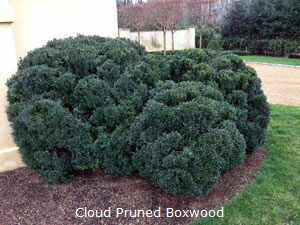|
About Cleaning and Pruning Boxwoods
A beloved shrub in Tennessee landscapes, boxwoods can live for many decades (even centuries!) when well tended. Given their naturally dense growth habit, boxwoods benefit from annual or biennial cleaning out and shaping to promote light and air in the interior of the plant. This practice helps control fungal issues, which can be a problem in our steamy summers and heavy soils.
February is when we clean out and do major boxwood pruning. Healthy boxwoods typically have internal branches that die as the shrub enlarges and older growth gets shaded out. Cleaning out boxwoods involves removing all such deadwood, which can be a reservoir for disease. After this cleaning is done we prune.
Pruning boxwoods typically takes two forms: rounded, which is self explanatory, and clouded.
 Cloud pruning gives a very distinctive ‘billowing’ appearance to boxwoods and is derived from Japanese pruning techniques. This approach is not just employed for its widespread aesthetic appeal, however. Cloud pruning promotes the overall health of the plant, particularly of large specimens, as it allows more light and air into the interior of the shrub than round pruning. Cloud pruning gives a very distinctive ‘billowing’ appearance to boxwoods and is derived from Japanese pruning techniques. This approach is not just employed for its widespread aesthetic appeal, however. Cloud pruning promotes the overall health of the plant, particularly of large specimens, as it allows more light and air into the interior of the shrub than round pruning.
Boxwood Annual Care Program
Due to their slow growth and long life, boxwoods can represent a significant financial investment in a landscape – the cost to replace a large old boxwood can easily run up into the thousands of dollars.
Although boxwoods are relatively undemanding plants, our heavy, poorly draining clay soils in middle Tennessee can make optimal boxwood culture tricky to achieve. We’ve developed our boxwood program specifically to address the challenges facing established boxwoods in our area.
Boxwood Fungal Issues
The fungus we see affecting boxwoods most commonly in these parts is Volutella, colloquially known as boxwood canker. This fungus is widespread, and the spores drift on the wind. Volutella is what makes one section of a bush ‘bronze out’ and not put out new growth, while the rest of the plant looks normal. Eventually sections of the bush die, with the tan dead leaves clinging to the dead twigs.
Another new and scary disease is boxwood blight, which came over the pond from Europe in the last few years. This fungus is generally fatal to an infected plant. Many studies are being conducted on overcoming boxwood blight; it appears at this point that some varieties show far more resistance than others, which is helpful for new installations.
With all fungal issues, it’s far more possible to prevent the problem than to cure it, which is why we preventatively spray healthy boxwoods and strongly recommend annual clean out and pruning. Please see our separate entry on boxwood pruning for more information.
Boxwood Pest Issues
The most prevalent insect pest on local boxwoods is the boxwood leafminer. Severe infestations of this pest can seriously injure or even kill a shrub through premature defoliation, so control is a good idea. Please see our separate entry about this problem for a full description of the pest and its treatment.
The other commonly seen bad actor is boxwood mite, whose damage shows up as tiny light stipples on the leaves. Minor infestations don’t affect generally healthy boxwoods, but weakened plants (usually those suffering from poor drainage) can get such a heavy population of the sap-sucking mites that the weakened plant appears pale and off-color.
Boxwood Care Program
- February - Clean out, major pruning and fertilization; fungicide spray
- Late April - Leafminer spray
- Last half of August - Leafminer spray or drench, fungicide spray
|